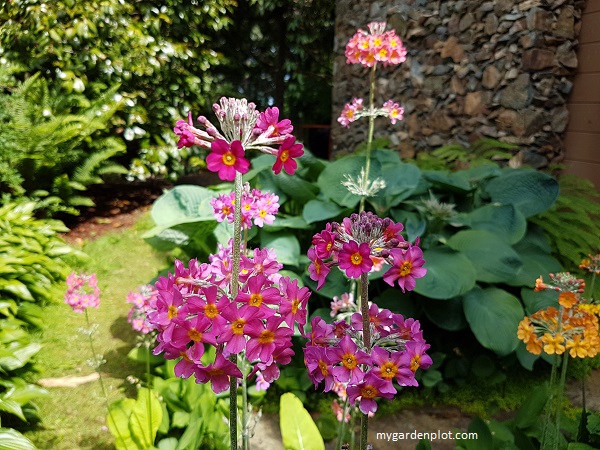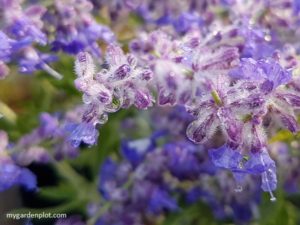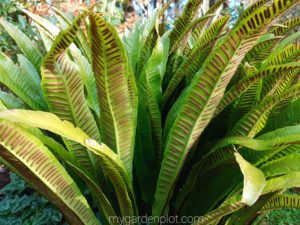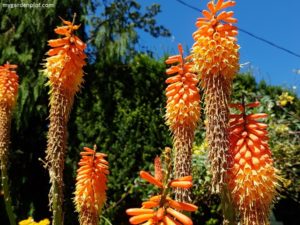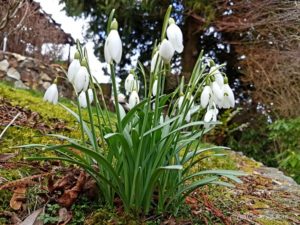About Proliferae / Candelabra Primula (Candelabra Primrose)
The primula candelabra group is one of the most elegant species of the primrose family. Most are native to the Himalayas and East Asia. They are often selected for boggy garden beds or moisture-retentive soil conditions, for colour and architectural interest in a border. They attract hummingbirds, bees and butterflies but are deer and rabbit resistant. Here is a guide to where to plant and how to grow and care for candelabra primulas.
The candelabra primroses are easy to care for, long-lived, hardy perennials. These dependable primroses have unique long stems with flowers borne on several whorls, from two to eight, per stem. Depending on the candelabra primrose species, these tiered blossoms can last from mid-spring through to early summer. These show best planted in groups and mixed colours, which can range from pink, purple and red to yellow and orange. In our garden, we have them grouped along with the hostas and western maidenhair ferns. They also grow well with other acid-loving plants like rhododendrons and camellias.
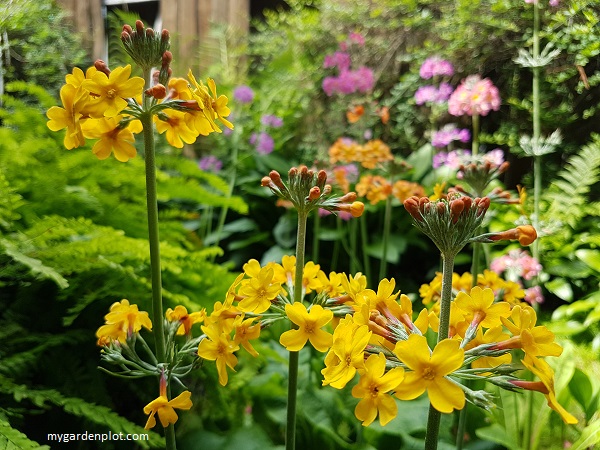
Candelabra Primulas (Candelabra Primroses) At A Glance
Type: Decidous / Herbaceous Perennials / Semi-evergreen
Location: Partial Shade
Seasonal Interest: Mid Spring to Early Summer Flowers
Size: Height varies 30-90 cm (1-3 ft)
Cold Hardiness Zones: 4, 5, 6, 7, 8, 9
Where To Plant And How To Care For Candelabra Primulas (Candelabra Primroses)
Plants that generally like bog gardens thrive in soggy soil but prefer not to be ‘bathing’ in standing water. The candelabra Primula group is no different. Most are water-loving primroses that prefer cool summers. They thrive in moisture-retentive, humus-rich soil that is slightly acidic. Plant in a partially shady location away from the hot summer sun, but not in deep shade. They do well in a north-facing shady wet border, damp woodland garden or at the edge of a stream or pond.
Candelabra primulas are low maintenance clump-forming plants that happily self-seed year after year. If they start growing where you don’t want them to grow in, they are easy to remove.
Add rich organic matter and mulch in late winter or by early spring to feed and help prevent the soil from drying out. Keeps their roots cool too during the summer. Care should be taken to ensure the soil never dries out. They are not tolerant to dry conditions. Ensure these primroses receive regular water throughout the summer.
When they have finished their cycle of flowering, remove the stems with the wilted flowers. Some candelabra primulas keep their leaves green through to winter, at which time they die back. Winter care is minimum. In colder regions where cold temperature fluctuates, leave the faded leaves to help insulate the primrose root zone. At the end of winter, remove the faded old leaves and tidy the area from any dead matter to be ready for regrowth in spring.They will reliably return year after year.
RELATED TOPIC: Buyer’s Guide On How To Choose Hand Pruners (Secateurs)
Pests And Disease That Affect Candelabra Primulas
Candelabra primulas need soggy soil conditions and will die if allowed to dry out. Occasionally root weevil larvae can affect them by burrowing into their roots, and slugs and snails may take a nibble. Otherwise, they are generally trouble-free. And they are deer and rabbit resistant.
Recommended Candelabra Primrose Varieties
P. beesiana – The flowers of the P. beesiana are deep pink or reddish-purple colour with yellow centres or ‘eyes’. The P. beesiana is native to China. Height and spread is around 30 x 20 cm (12 x 8 in).
P. bulleyana – Also native to China, the P. bulleyana is semi-evergreen. Initially, the buds are orange or red, but the flowers that emerge range from yellow and orange to pink and red. Height and spread is about 50 x 20 cm (20 x 8 in).
P. japonica – The P. japonica, or Japanese primrose, has purple or pink flowers with dark eyes. There is a pretty variety with white flowers and a yellow centre. As the name implies, P. japonica is native to Japan. Height and spread generally 40 x 20 cm (16 x 8 in).
P. prolifera – The P. prolifera (syn. P. helodoxa) has fragrant flowers that vary from light to dark yellow. Originally from Northeast India, Myanmar, South China, Malaysia and Java (Indonesia). Height and spread is around 60 x 20 cm (24 x 8 in).
P. pulverulenta – The P. pulverulenta is native to China and has deep red, pink or purple flowers with darker eyes. These have a distinctive wrinkled leaf form and whitish stem. Height and spread is generally 80 x 20 cm (32 x 8 in).
RELATED TOPIC: Spring Gardening Highlights And Plant Recommendations

